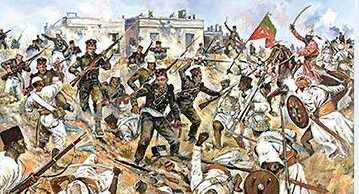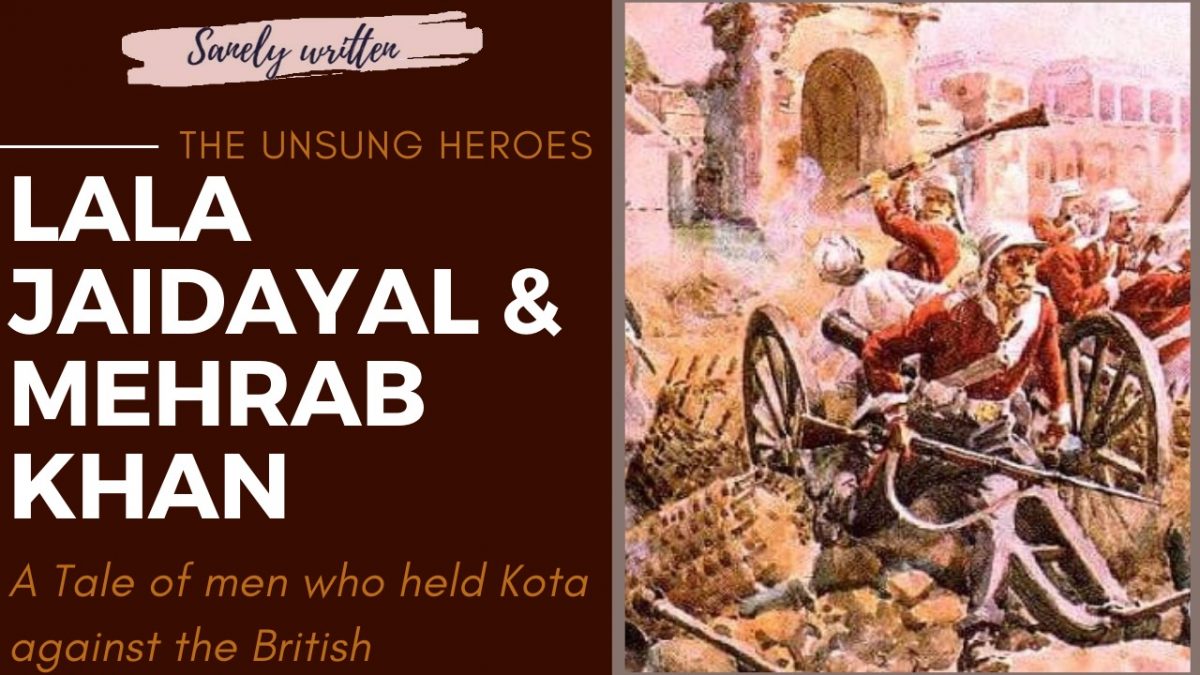We all know about the Great War of Independence 1857. We have heard tales about Mangal Pandey, Nana Saheb and the Queen of Jhansi, Rani Lakshmibai. But there was also an uprising that took place in Kota district of Rajasthan in the same year led by Lala Jaidayal Bhatnagar and Mehrab Khan, and we have neither heard of them, nor do we have any pictures of the unsung heroes.
Lala Jaidayal was born on 4th April 1812 in Kama in Bharatpur. After completing his early education, he was appointed as an Advocate by the Kota Maharao in Hadaoti Agency. He was the prime leader of the Kota uprising. Mehrab Khan, his associate was the ‘Risaldar’ in the Kota army and was born on 11th May 1815 in Karoli. Lala Jaidayal along with Mehrab Khan had issued a circular in which they described in detail, about the new weaponry that was used by the British army that had its cartridges made up of animal flesh which was against the religious sentiments of both the Hindus and the Muslims. They also described how the flour and other eatables had the granules of human bones mixed in them. They made an appeal to the people to destroy the British who were intoxicating their lives.
The troops had started feeling the atrocities committed to them and what fuelled the fire was an advice given to the then ruler of the Rajputana state of Kota, Handa Rajput Maharao Ram Singh by the political agent of Kota, Major Burton, which somehow reached the troops. He advised Maharao to dismiss some of his non British soldiers. This message triggered the fire of discontent among the troops. Major Burton had visited Kota on 12th October 1857, with his two sons Frank who was 21 and Arthur who was 16. Maharao ordered a salute in honour of the British annexation of Delhi. The advice was given to Maharao on 14th October 1857 when Burton went to meet him along with his sons. The Kota Raj Pultan, furious with the news, decided to revolt against the King and Major Burton on the very next day i.e. 15th October 1857.
The troops, fuelled with anger, collected their swords and guns and surrounded the residency bungalow. They were also joined by the local civilians. The guards of the palace, having surrounded by around 3000 people offered almost zero resistance. The troops open fired and soon the palace was taken over. Major Burton, on hearing the commotion, thought that it was a procession that was coming out to welcome his return but he wasn’t aware of the reality. First among the victims of the mutineers were Dr. Salder, a native surgeon and a native Christian of Kota dispensary, Dr. Contemm.
A minute by minute description was given by Khoom Singh, the shooter sawar of Major Burton. He was with Major Burton and his two sons till the very end. They ran upstairs. Every Chawkidaar and Chaprasis that were appointed for the safety of Major Burton had run away when they saw the rebels coming. They climbed the ladders and killed Major Burton and both his sons. A parade was taken out by the rebels in the city with the severed head of Burton and was later fired upon with a gun.

The rebels took over the city and Lala Jaidayal was in charge of its administration. Maharao was captured and imprisoned in his own palace. Her queens were sheltered by Maharaja of Udaipur on the request of Maharao but five of his most trusted people were executed with guns as they refused to side with them. Gosain Maharaj, who was the religious head of Kota, acted as a mediator and Maharao had to walk into a treaty with the rebels. He was made to sign an agreement which stated that Major Burton was killed at his instance. For 6 months, the administration of Kota was under Jaidayal, and Mehrab Khan was incharge of the defence of the city. He sought help from the ruler of Sumbalgarh, Vitthal, which shows his ability as an able diplomat. Jaidayal also received a letter from the Thakur of Salumber (Mewar) in which he asked Lala to join him. They were able to win the love and support of a large number of officers in Kota state and many of them were posted in districts and were given the charge of many forts and palaces. But their rule didn’t last long and they were dislodged by the British troops along with the Maharaja of Karauli on 30th March 1858. Jaidayal left Kota and went to Bikaner. A bounty of 12000 was declared on him by the rulers of Kota and Bundi.
An analysis of the events that happened during this rebellion reveals how well planned and well
organized it was. They were hugely supported by the civilians and also by the state officials. They mostly attacked government offices and stores. The rebellion was against the British but when they came to know that Maharao was seeking help from them, they became furious and started the campaign against him. The aftermath of these events were even more heinous. The British troops burned down houses and property and plundered each and every house they came across. The ornaments that decorated the statues of lord Ganesha were also not spared. The followers of Lala Jaidayal and Mehrab Khan were put through miseries and were subjected to merciless torture. Maharao of Kota was unable to control the uprising. The native people were strongly anti-British and General Lawrence, the agent of Governor General and Maharao were aware of their feelings. They also cautioned Major Burton not to visit Kota. This was the reason why he visited Kota just with his two sons, and the rest of his family, including his wife and four other sons, were in Neemuch.
The fact that the leaders of the uprising, Lala Jaidayal and Mehrab Khan were Hindu and Muslim inspired the people of both religions to join hands against the tyranny of the British. The deep rooted dissatisfaction, the constant injustice, and the able leadership of Jaidayal and Mehrab Khan gave them the strength to stand behind their leaders and fight for the atrocities committed against them.
The greed for money has always been one of the main curses that the people of this country have faced throughout history. Same as the case with Liliya, who was responsible for the arrest of Lala Jaidayal Bhatnagar. The trial started in the court of political agent of Hadauti, W.H. Benan during April-May 1860 and he was given death penalty on 17th September 1860 in Kota.
Reference/s:
1. The people’s rising in Kota during the upheaval of 1857 by Vinita Parihar
2. The dictionary of Martyrs of the freedom struggle of India




9 replies on “Lala Jaidayal & Mehrab Khan”
Nice job
So well put out !!
लाला जयदयाल और मेहराब खां को फांसी दी गयी थी या तोप से उड़ाया गया था???
लाला जयदयाल और मेहराब खां को फांसी दी गयी थी| Source
??✨
Salute to both leaders!
Salute to both leader
Salute to both leaders
Dono netao krantikariyo ko salam